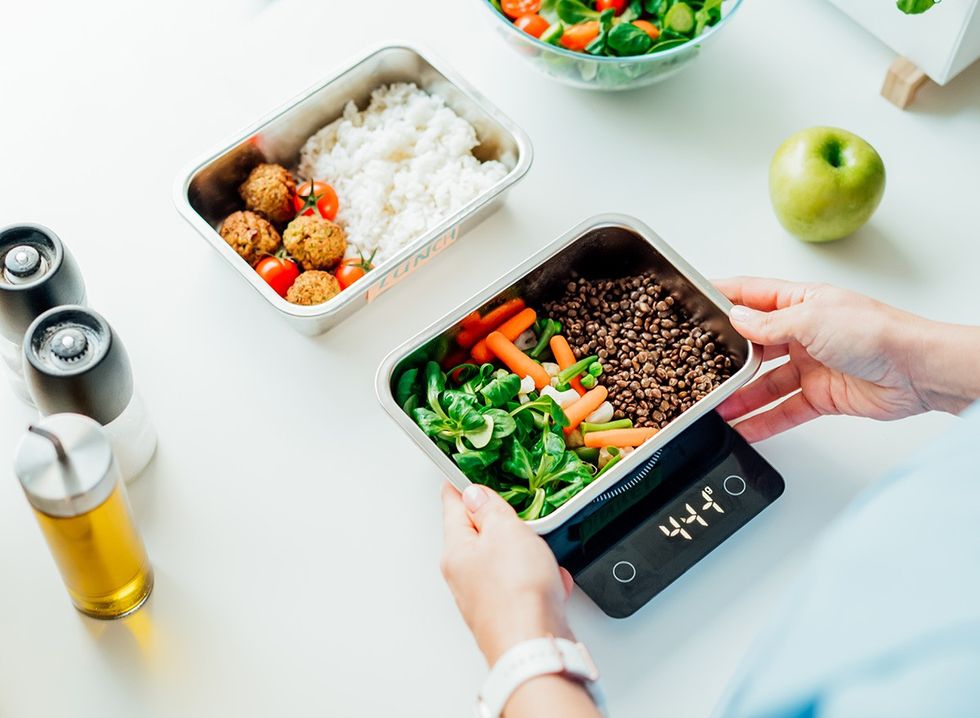Walking is a truly underrated method of fat burning. Low impact, sustainable, and suitable for essentially any fitness level, walking has benefits beyond just physical. “Research has shown that walking at a brisk pace at least 150 minutes a week can help you think better, feel better and sleep better,” says the American Heart Association. “If 150 minutes sounds like a lot, remember that even short activity sessions can be added up over the week to reach this goal. And it’s easy to fit in a few minutes of walking several times a day. This could be 10 minutes of brisk walking after breakfast, lunch and dinner.” Here are seven ways to burn belly fat through simply taking a walk.
Use a Weight Vest

Using a weight vest can give your walks a little challenge—studies show it can help burn more calories. “So doing something as simple as wearing a weighted vest on your daily dog walk could have a big benefit to your physical health – including your cardiovascular health and metabolism,” says Christopher Gaffney, senior lecturer in Integrative Physiology, Lancaster University, via The Conversation.
Take a Hike

Hiking is another great way to burn extra belly fat, by walking at an incline. “Incline walking is simply walking on a gradient, and it mimics hiking but poses little risk like that found on rugged terrain,” says Chance Ruggeroli, a personal trainer on the staff at Texas Health Fitness Center in Burleson. “My best recommendation is to pace yourself and leave room to grow. Walk, don’t run. Pun fully intended.”
Bring a Friend

Walking with a friend not only makes the exercise more fun, but you’re more likely to actually do it. “Going for a brisk walk with one or more friends is a form of socializing, which is essential for good health,” say the experts at Harvard Health. “Socializing helps stave off isolation and loneliness, which are associated with heart disease, diabetes, arthritis, depression, chronic stress, and premature death.”
Related: This Is Exactly How to Lose Body Fat This Year
Use a Treadmill

Bad weather keeping you inside and away from your favorite walking spots? The treadmill is your friend. "The treadmill has a predictable surface that is much easier to negotiate than sidewalks, curbs or trails and the risk of tripping is reduced," according to Spine Health. "Users can do other things while on the treadmill, such as watch television or read, which for many can help keep the exercise interesting."
Wear the Right Shoes

Wearing the correct shoes for your walks is very important. “Doing so will help keep your feet healthy, make your physical activity easier, and help keep your body safe from injury,” according to DHS.gov. “If your shoes are too tight, too loose, or insufficiently supportive, your physical activity may place stress on your feet, ankles, lower legs, and other joints. This ongoing pressure can contribute to pain and injuries. You will be more comfortable being active if you choose a supportive shoe that fits you well and suits your activity.”
Walk For 30 Minutes

Try to walk for at least 30 minutes to get the most out of your exercise. “If you walk briskly (at a pace of 4 miles per hour) for 30 minutes on five out of seven days, you'll log 10 miles a week,” say the experts at Harvard Health. “That means it would take three-and-a-half weeks to lose one pound if the number of calories you consume stays the same.”
RELATED: I Lost 50 Pounds While Eating These Foods Every Day
Make it Fun!

Make your walks fun—if it’s actually enjoyable, you’re more likely to stick with a good fitness regimen. Walk with friends and family, compete with coworkers by doing step challenges, listen to music or catch up with podcasts, spend time with a beloved dog… all of these things make walking better.
💪🔥Body Booster: Start off gently, build up endurance, and make sure you have good walking shoes.








 Olive OilShutterstock
Olive OilShutterstock It's Now Part Of My LifeShutterstock
It's Now Part Of My LifeShutterstock Beans and Lentils: The Hunger-Fighting Fiber ChampionsShutterstock
Beans and Lentils: The Hunger-Fighting Fiber ChampionsShutterstock SalmonShutterstock
SalmonShutterstock 12 Surefire Ways to Lose Abdominal Fat, Say ExpertsShutterstock
12 Surefire Ways to Lose Abdominal Fat, Say ExpertsShutterstock Chronic StressShutterstock
Chronic StressShutterstock Shutterstock
Shutterstock Remember:Shutterstock
Remember:Shutterstock







 Shutterstock
Shutterstock Shutterstock
Shutterstock Shutterstock
Shutterstock Shutterstock
Shutterstock Shutterstock
Shutterstock
 Shutterstock
Shutterstock Shutterstock
Shutterstock Shutterstock
Shutterstock Shutterstock
Shutterstock Shutterstock
Shutterstock Shutterstock
Shutterstock Shutterstock
Shutterstock Shutterstock
Shutterstock Shutterstock
Shutterstock Shutterstock
Shutterstock
 Shutterstock
Shutterstock Shutterstock
Shutterstock Shutterstock
Shutterstock Shutterstock
Shutterstock Shutterstock
Shutterstock
 Shutterstock
Shutterstock Shutterstock
Shutterstock Shutterstock
Shutterstock Shutterstock
Shutterstock Shutterstock
Shutterstock Shutterstock
Shutterstock

 I'm a Nutritionist and These 9 High-Protein Snacks Keep My Clients Full While Losing 50 Pounds
I'm a Nutritionist and These 9 High-Protein Snacks Keep My Clients Full While Losing 50 Pounds
 2. Processed FoodsShutterstock
2. Processed FoodsShutterstock Shutterstock
Shutterstock Shutterstock/Prostock-studio
Shutterstock/Prostock-studio Shutterstock
Shutterstock Pro TipsShutterstock
Pro TipsShutterstock Shutterstock
Shutterstock Shutterstock
Shutterstock Shutterstock
Shutterstock Shutterstock
Shutterstock Don’t Drink as Much AlcoholShutterstock
Don’t Drink as Much AlcoholShutterstock Most Women on GLP-1s Are Making a Few Common MistakesShutterstock
Most Women on GLP-1s Are Making a Few Common MistakesShutterstock Soda and Sugary DrinksShutterstock
Soda and Sugary DrinksShutterstock Shutterstock
Shutterstock Eat BreakfastShutterstock
Eat BreakfastShutterstock And Improve Insulin SensitivityShutterstock
And Improve Insulin SensitivityShutterstock Belly Flab Strip Tip: Sugar and Fat Calories Leave Its Mark on Your BodyShutterstock
Belly Flab Strip Tip: Sugar and Fat Calories Leave Its Mark on Your BodyShutterstock Shutterstock
Shutterstock The Drugs Mimic the GLP-1 Hormone Naturally Produced by the BodyShutterstock
The Drugs Mimic the GLP-1 Hormone Naturally Produced by the BodyShutterstock 3. Deep-Fried ItemsShutterstock
3. Deep-Fried ItemsShutterstock